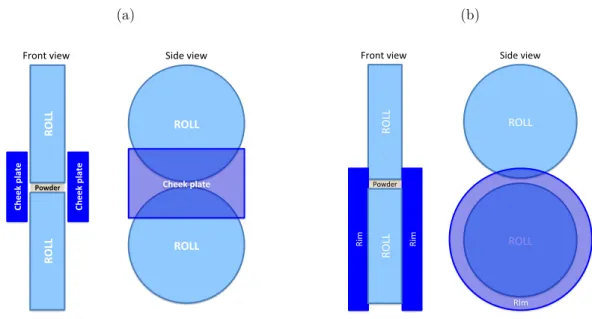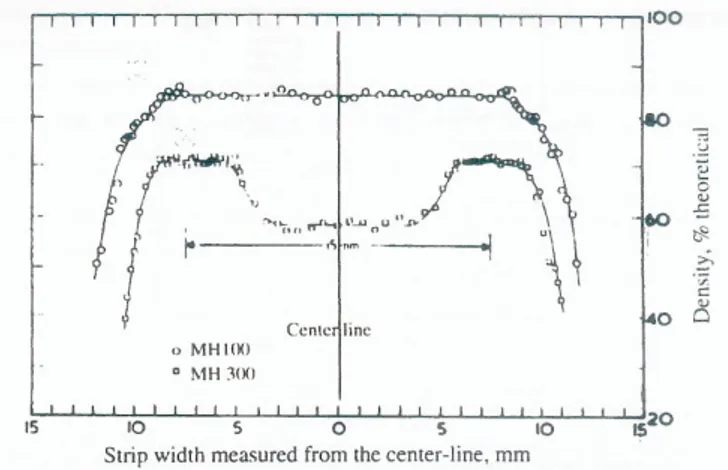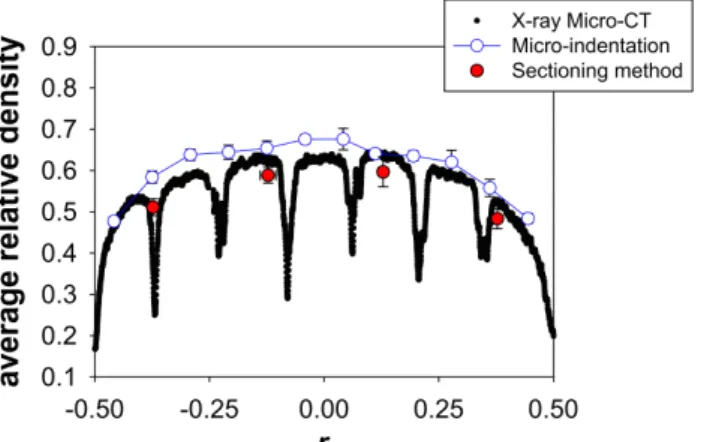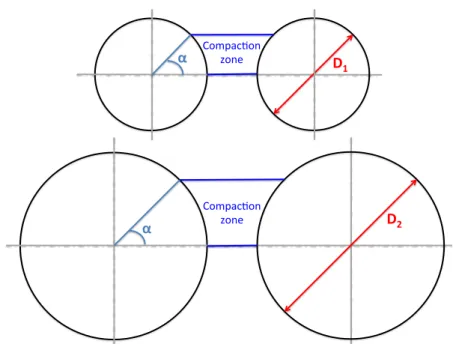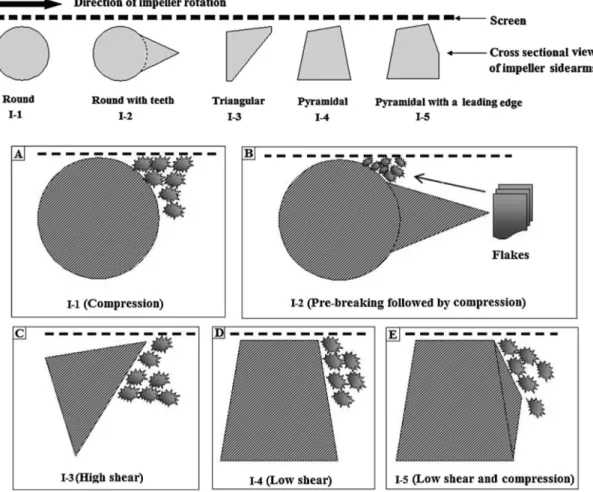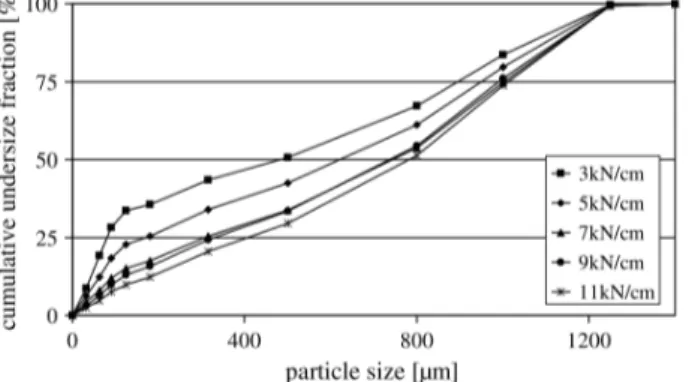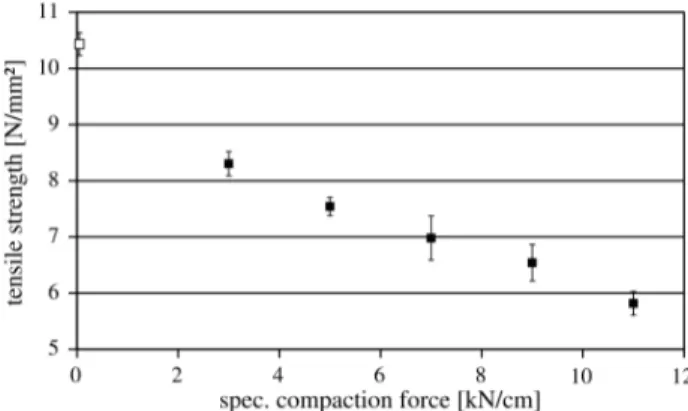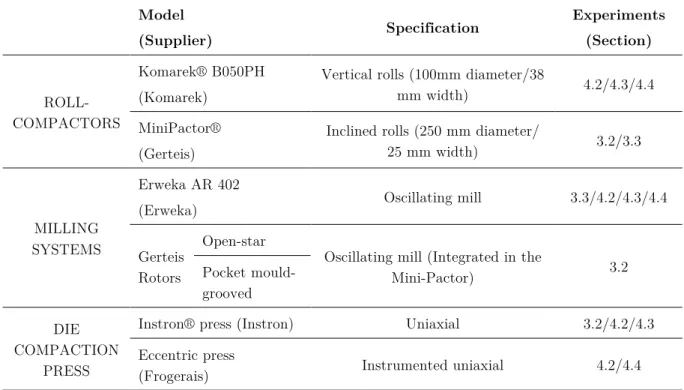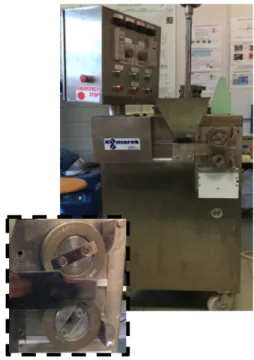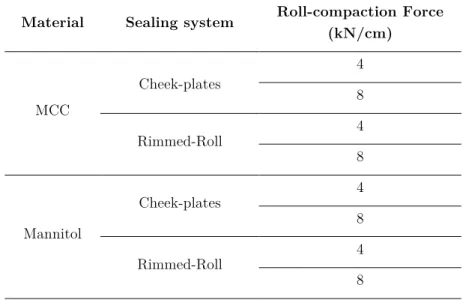HAL Id: tel-01598157
https://tel.archives-ouvertes.fr/tel-01598157
Submitted on 29 Sep 2017
HAL is a multi-disciplinary open access archive for the deposit and dissemination of sci-entific research documents, whether they are pub-lished or not. The documents may come from
L’archive ouverte pluridisciplinaire HAL, est destinée au dépôt et à la diffusion de documents scientifiques de niveau recherche, publiés ou non, émanant des établissements d’enseignement et de
Lucia Perez-Gandarillas
To cite this version:
Lucia Perez-Gandarillas. Dry granulation process and compaction behavior of granulated pow-ders. Chemical and Process Engineering. Ecole des Mines d’Albi-Carmaux, 2016. English. �NNT : 2016EMAC0021�. �tel-01598157�
THÈSE&
THÈSE&
& & En&vue&de&l’obtention&du&
DOCTORAT&DE&L’UNIVERSITÉ&DE&TOULOUSE&
& Délivré&par&:&École&Nationale&Supérieure&des&Mines&d’Albi7Carmaux&& & & & ! Présentée&et&soutenue&par&:&&Lucia&PEREZFGANDARILLAS&
Le&13&décembre&2016& Titre&:& DRY&GRANULATION&PROCESS&AND&COMPACTION&BEHAVIOR&OF& GRANULATED&POWDERS& & École&doctorale&et&spécialité&:& MEGEP%:%Génie%mécanique,%mécanique%des%matériaux& & Unité&de&Recherche&:& RAPSODEE%;%UMR%CNRS%5302;École%des%Mines%d’Albi;Carmaux% & Directeurs&de&Thèse&:& Directeur&:&Abderrahim&MICHRAFY& Co7directeur&:&Olivier&LECOQ& JURY&:&M.&Peter&KLEINEBUDDE& Professeur,&Université&de&Dusseldorf&(Allemagne)& Président& M.&Chuan7Yu&WU& Professeur,&Université&de&Surrey&(Angleterre)& Rapporteur& M.&Pierre&TCHORELOFF& Professeur,&Université&de&Bordeaux&(France)& Rapporteur& M.&Gavin&REYNOLDS&& Professeur,&Université&de&Sheffield&(Angleterre)& Examinateur& Mme&Ana&ANDRES&PAYAN& Professeur,&Unversité&de&Cantabria&(Espagne)& Examinateur&
! ! ! ! ! ! ! ! ! ! A"mis"padres."" Por$abrir$mis$alas$y$dejarme$volar$lejos$de$su$nido.$$ Por$su$incondicional$compañía$en$los$caminos$que$escogí.$$ ! ! ! !
“Caminante, son tus huellas, el camino y nada más; Caminante, no hay camino, se hace camino al andar. Al andar se hace el camino, y al volver la vista atrás se ve la senda que nunca se ha de volver a pisar. Caminante no hay camino sino estelas en la mar.”
A Spanish philosopher, named Ortega y Gasset, wrote in 1914 his famous quote “I am I and my circumstances”, expressing the relation between each person and the time and place where they are. This PhD work has been influenced by extraordinary “circumstances”. The friends I met, the colleagues I worked with, the places I had the opportunity to go, the smiles I found, the coffees I enjoyed… I hope that each person contributing to this work could find in these words my sincerest gratitude.
En premier lieu, je remercie l’École des Mines d’Albi-Carmaux et le centre RAPSODEE de m’avoir donné la possibilité de développer ces travaux de thèse. Tout le personnel du centre, sans exceptions, mérite ma reconnaissance pour leur gentillesse et leur disponibilité.
Mes remerciements sont aussi destinés aux membres du jury pour l’honneur qu’ils m’ont fait en évaluant mes travaux de thèse. Thank you very much to all the jury members. I appreciated enormously the discussion, suggestions and advices.
Je tiens à remercier très chaleureusement mes encadrants, Abder et Olivier. Ils m’ont accompagnée et supportée tout au long de ces trois années. Particulièrement, Abder a représenté plus qu’un directeur de thèse. Merci pour ton dévouement, ton soutien sans relâche, ton enthousiasme et tes précieux conseils que m’accompagneront toute ma vie. Quand les relations son simples et honnêtes, le travail devient un vrai plaisir !
Ces trois années auraient été beaucoup plus longues sans la compagnie de tous les doctorants, post-doctorants et stagiaires. Au début collègues de travail, maintenant des amis pour la vie. Merci d’avoir fait les heures plus courtes et les jours plus heureux ! D’abord, je remercie mes collègues du bureau coopératif LPH (même trop coopératif parfois!) : Paulo (j’ai compris la signification de ‘saudade’ quand tu es parti…) et Hugo (le français le moins français…). Discuter avec vous était, est et sera toujours un grand plaisir. Il y a aussi deux personnes qui ont été à mes côtés depuis le premier jour : Marwa (tu as été ma famille ici et, quand je penserai à Albi, tu seras toujours mon meilleur souvenir) et Haithem (impossible to reduce to few words all the moments by your side !). Merci à Marta, Andrés, Graciela et Stephan (mes amis hispanophones), Bruna et Andrea (à leur côté, la vie est un «carnaval»), Margot (et Remi), Fanny, Leo, Damien, Marion, Zenia, Jacqueline, Elias, Nayane, Brieuc, Roger, Bhianca, Chaima, Rababe, Javier, Danilo, Marcos, Julia,… Vous trouverez toujours un «chez nous» à Santander. Je ne peux pas oublier Noémie, Claudine et Manolita.
This work has been part of the European project IPROCOM. Being part of a Marie-Curie fellowship is more than simply research. The multicultural and interdisciplinary atmosphere has enriched me not only professionally but also personally! Thank you to all of them, from supervisors to fellows; especially to Alon, the other IPROCOMer “Albigeois”.
Finally, I would like to thank the most important people to me: my family, my boyfriend and my Spanish friends. Wherever I live, they will always be my home. They defined who I am today. Far from science, they taught me what matters in life. Gracias!
Particulate solids such as pharmaceutical powders often require size enlargement processes to improve the manufacturing properties like flowability. For that reason, dry granulation by roll compaction has been widely used in the pharmaceutical industry. The process consists of compressing powders between two counter-rotating rolls to produce ribbons that will be subsequently milled into granules. The obtained granules are tableted for oral dosage. In this process there are two main limitations: the existence of different designs of the roll compactors, milling systems and the interaction between process parameters and raw material properties are still a challenge and the roll-compaction process leads to an inferior tensile strength of tablets compared with direct compression. These aspects are investigated in this work. In the first part of this thesis, an analysis on the effect of different roll-compaction conditions and milling process parameters on ribbons, granules and tablet properties was performed, highlighting the role of the sealing system and the ribbon density distribution characteristics. In the second part, die compaction of roll-compacted powders, as the last stage of the process, is further investigated in terms of experimental analysis (effect of the granule size and composition and stress transmission measurements) and modelling the compaction behavior of granules.
Resumé
Les solides divisés telles que les poudres pharmaceutiques nécessitent souvent des processus d'agrandissement de taille par agglomération pour améliorer leur comportement mécanique, notamment la coulabilité. Pour cette raison, le procédé de "granulation en voie sèche" est utilisé dans l'industrie pharmaceutique. Le procédé consiste à comprimer la poudre en la faisant passer entre deux rouleaux séparés par un entrefer, pour produire des plaquettes qui sont ensuite broyées en granulés et comprimés en compacts. Dans ce procédé, l'existence de différents modèles de compacteurs à rouleaux et de systèmes de broyage d’une part, et l'interaction entre les paramètres des procédés et des propriétés des produits (plaquettes, granulés et comprimés) d’autre part, rendent difficile la compréhension des phénomènes et des mécanismes sous-jacents. En particulier, le procédé entraîne une perte de résistance mécanique des comprimés formés à partir de granulés (comparativement à celles des comprimés de poudres non-granulés) et ce phénomène est encore mal compris. Ces aspects sont étudiés dans ce travail de thèse en menant des caractérisations expérimentales et des modélisations numériques permettant de mieux comprendre les modifications micro et macro structurales des poudres mises en forme par granulation sèche. Le but ultime est de progresser dans la compréhension des relations "propriétés des poudres - paramètres des procédés". Enfin, la compréhension des différences de comportement en compression de poudres granulées et non-granulées est menée à l’aide
List of symbols 1
Introduction 3
Chapter 1. State-of-the-art 7
1.1. Dry granulation and tableting 9
1.2. Roll-compaction process and challenges 10
1.2.1. Roll-compaction technology & theoretical background 10
1.2.2. Process design and operational parameters 13
1.2.2.1. Feeding system 13
1.2.2.2. Vacuum de-aeration system 14
1.2.2.3. Sealing systems 14
1.2.2.4. Screw and rolls speeds 15
1.2.2.5. Gap and compaction pressure 17
1.2.3. Common problems and progress 18
1.2.3.1. Heterogeneity of ribbon density 18
1.2.3.2. Heterogeneity of roller pressure 23
1.2.3.3. Trapped air into powders 25
1.2.3.4. Scalability of the process 25
1.2.4. Conclusions! 27
1.3. Milling process and characterization approaches 29
1.3.1. Milling process technology 29
1.3.2. Process parameters and granules properties 30
1.3.3. Ribbon properties and granules properties 34
1.3.4. Conclusions 34
1.4. Mechanics of die-compaction and modelling 36
1.4.1. Compaction behaviour of granulated powders 37 1.4.1.1. Granules compaction effects on rearrangement and plastic
deformation
37
1.4.1.2. Granules compactability 40
1.4.2. Conclusions 43
1.5. Conclusions 44
Chapter 2. Materials and experimental procedures 47
2.1. Pharmaceutical powders 49
2.2. Process equipment 50
2.2.1. Roll-compactors 51
2.3.1. Ribbon properties 57
2.3.1.1. Density distribution 57
2.3.1.2. Milling performance of ribbon pieces 58
2.3.2. Granules properties 59 2.3.2.1. Morphology 59 2.3.2.2. Size distribution 59 2.3.3. Tablets properties 59 2.3.3.1. Compressibility 60 2.3.3.2. Compactability 60 2.3.3.3. Stress transmission 61
2.4. Continuum model and calibration 61
2.4.1. DPC Calibration 63
2.4.1.1. Determination of the shear failure surface parameters 63 2.4.1.2. Determination of the cap surface parameters 66
2.5. Conclusions 66
!
Chapter 3. Roll-compaction and milling results 69
3.1. Introduction 71
3.2. Impact of operational parameters on the material properties 72 3.2.1. Ribbons properties: appearance and bulk density 73
3.2.2. Granules morphology 75
3.2.3. Amount of fines 76
3.2.4. Tabletability of roll-compacted granules 80
3.2.5. Conclusions 86
3.3. Sealing system and ribbon density distribution 87
3.3.1. Density distribution 87
3.3.2. Milling performance 91
3.3.2.1. Mass throughput 91
3.3.2.2.Granule Size distribution 93
3.3.3. Conclusions 94
3.4. Conclusions 96
Chapter 4. Die-compaction results and modelling 99
4.1. Introduction 101
4.2. Compaction behaviour of granulated powder based on DPC analysis 102 4.2.1. Cohesion and internal friction coefficient 104
4.3.2. Granules size and shape 114
4.3.3. Compressibility 115
4.3.4. Compactability 117
4.3.5. Conclusions 119
4.4. Stress transmission analysis 120
4.4.1. Axial transmission 120
4.4.2. Radial transmission 122
4.4.3. Conclusions 123
4.5. Conclusions 124
General conclusions and perspectives 127
Resumé long en français 131
References 143
List of figures 151
List of tables 157
m" Powder mass (g)
h" Tablet height (cm)
D" Tablet diameter (cm) ρt" True density (g/cm3)
ρr" Relative density -
P" Applied compaction pressure (MPa) K" Heckel coefficient (MPa-1)
A" Heckel constant -
Py" Mean yield pressure (MPa)
Fd" Force (required to break the tablet diametrically) (N)
Fc" Force (required to break a tablet in axial compression) (N)
σd" Diametrical tensile strength (MPa)
σc" Compression failure strength (MPa)
σu" Pressure upper punch (MPa)
σl" Pressure lower punch (MPa)
σr" Pressure in the die wall (MPa)
ϕaxial" Axial stress transmission -
ϕradial" Radial stress transmission -
p" Hydrostatic pressure (MPa) q" Equivalent stress (MPa) Fs" Shear failure function -
Fc" Cap surface function -
d" Cohesion -
β" Angle of internal friction (°)
R" Cap eccentricity -
α" Transition constant - Pa" Hydrostatic pressure at the intersection of the shear failure and
the cap surface
Introduction
Dry granulation by roll-compaction consists basically of passing a mixture of powders through two rotating rolls, which converts the powder into a ribbon under the application of mechanical actions. The ribbons are subsequently milled into granules using a milling system. The produced granules with improved properties are used in subsequent processes as tableting or capsule filling. The process was firstly developed for metal and ceramic powders and it has been widely used in the pharmaceutical industry in the last decade. The major advantage of dry granulation is the continuous production without drying stage, leading to the reduction in costs.
Although the dry granulation by roll-compaction process may appear rather simple at first glance, the diversity of factors affecting the quality of materials renders the interpretation of results difficult. The structural changes to which the powder is subjected in order to be transformed into ribbons, granules and tablets remains not fully understood. The lack of process understanding makes the product development and the process design a challenging task. Currently, the trial-and-error method has been used for the optimisation of each specific production, which results in time and cost consumption, and up to date, the knowledge to scale-up the process from development equipment to commercial equipment is still limited.
In this context, the project IPROCOM (ITN-Marie Curie Actions) was created to develop robust process models that can be used to predict the properties of intermediate (ribbons/granules) and final products (tablets) based on the properties of individual particles. The overall approach is to bridge the current knowledge gap on how material properties of single particles and process conditions govern the product properties. For that, a multi-disciplinary approach was employed, including experimental studies at microscopic and macroscopic scales, multi-scale numerical models and computational intelligence modelling.
This doctoral research was integrated in the IPROCOM project and it has been developed at the RAPSODEE Centre-UMR CNRS in the School of Mines of Albi (France), in collaboration with the other project partners.
The main objective of this thesis is to obtain a deeper understanding of the dry granulation process through detailed experimental studies of roll-compaction, milling and die-compaction for different model pharmaceutical powders. More specifically, the objectives of this thesis include:
i) To explore the effect of roll-compaction and milling conditions on the ribbons, granules and tablet properties. The experiments carried out will give key hints for the comprehension of the process and its effect on the variability of the product attributes such as ribbon density, granule size distribution and tablet tensile strength.
ii) To investigate how roll-compaction affects the uniaxial compaction behaviour of powders. In particular, the impact of the mechanical granules properties on the properties of compacted tablets is analysed. For that, it is essential to compare feed powders with produced granules.
This doctoral thesis is organised in distinct chapters:
Chapter 1 describes the state-of-the-art of the research and development related to
the roll-compaction, milling and die-compaction processes. The dry granulation process and the theoretical background of the processes are introduced. The impact of the process on mechanical properties of the processed powders and the intermediate products (ribbons, granules and tablets) are also reviewed. The research progress on the understanding of the complex relationships between process parameters and measurable properties are discussed through the literature results.
Chapter 2 presents the pharmaceutical excipients with distinctive properties (to
evaluate the sensitivity of the process to the properties of the feed powder), the equipment (including roll-presses, milling systems and die-compaction presses), the experimental procedures (experiments under diverse operational conditions were carried out) and the techniques used for characterizations (such as ribbon density, granule size distribution or compactability of tablets). Moreover, in this Chapter, the Drucker-Prager Cap model is presented, with the goal of comparing the compaction mechanisms of feed powder and granules. The equations of the model and the calibration procedure are included.
establish the interrelation between the parameters and product properties, having a global consideration of the chain process. First, operational parameters such as the roll-compaction force, the sealing system, the mill type, the mill speed and the angle of rotation were evaluated in terms of amount of fines and tablet tensile strength. In addition, the most significant parameters were determined through the performance of a statistical analysis. Secondly, the role of the sealing system is further investigated based on the measurement of the ribbon density distribution. Moreover, the milling mass throughput and the granule size distribution are also presented as a function of the obtained results of the ribbon density distribution.
Chapter 4 presents the results of the compaction of dry granulated material. The
effect of the roll-compaction process on the compaction behaviour of granulated powders was analysed and discussed through the characterization of the Drucker-Prager Cap model, analysing the material parameters such as cohesion or angle of internal friction for both feed powder and granules. Also in this chapter, the densification mechanisms of roll-compacted binary mixtures (mixtures of plastic and brittle materials) are investigated, focusing on the role of the composition, the granule size effect and the measurements of the stress transmissions.
General conclusions and perspectives. In this part, the main conclusions from the
discussed results in this thesis are included, together with the opened perspectives that can be further developed as a continuation of the present results.
State-of-the-art
Abstract
The aim of this chapter is to present the state of the art of the research and development related to the chain of process “roll-compaction, milling and die-compaction” used in pharmaceutical industry and their impact on mechanical properties of the processed powders and the intermediate products (ribbons, granules and tablets). Firstly, dry granulation process based on roller compaction technology and the theoretical background of the process are introduced. In particular, the significant progress on the understanding of the complex relationships between process parameters (feeding systems; roll surfaces and speed; sealing systems; de-aeration systems) and measurable properties (ribbon density distributions, roll pressure distribution…) are reviewed and discussed. Secondly, the milling process, which transforms ribbons into granules by mechanical actions, is described and the main results from the literature are reviewed, especially for the effect of the process parameters on the production of fines. Finally, the basic mechanics of die compaction as the final step of the production chain is then introduced and the main phenomena of the granules behaviour and properties of tablets produced from roll-compacted granules (comparatively to tablets compacted from raw material) are reviewed and discussed. Results from the literature, which are generally focused on each process alone rather than the whole production chain, show that the full understanding of the changes in the mechanical behaviour from the raw material to tablets remains a challenge and the progress in this topic, probably needs to be based on the combination of both experimental analysis by developing new measurements for local properties and multi-scale modelling approach.
Resumé
Le but de ce chapitre est de présenter l'état de l'art de la recherche et de développement liés à la chaîne de procédés "compactage à rouleaux, broyage et compactage» utilisée dans l'industrie pharmaceutique ainsi que leurs impacts sur les propriétés mécaniques des produits intermédiaires (plaquette, granulé et comprimé). Tout d'abord, le procédé de granulation sèche
basé sur la technologie de compactage à rouleaux ainsi que les connaissances théoriques de base sont introduits. Les progrès significatifs concernant la compréhension des relations complexes entre les paramètres du procédé (système d'alimentation; surface des rouleaux; vitesse; système de confinement des rouleaux; système de désaération de la poudre) et des propriétés des plaquettes produites (distributions de densité de plaquette, distribution de pression appliquées par les rouleaux...) sont ensuite revus et discutés. D'autre part, le procédé de broyage, opération qui transforme les plaquettes en granulés par des actions mécaniques, est décrit ainsi que les principaux résultats de la littérature sont discutés, en particulier, l'effet des paramètres du procédé sur la production de particules fines. Enfin, les mécanismes de base de compactage en matrice sont ensuite décrits et les principaux phénomènes observés lors de la compression de poudres granulés et de poudres avant granulation, sont examinées et discutées. Les résultats de la littérature, qui généralement concentrent chaque procédé seul plutôt que considérer toute la chaîne de production, montrent que la compréhension des changements de comportement mécanique des poudres reste un défi technologique et scientifique et que les progrès dans ce domaine, nécessiteront probablement, une analyse expérimentale fine par des mesures locales des propriétés combinée à des approches de modélisation multi-échelles.
Table of contents
1.1. Dry granulation and tableting ... 9!
1.2. Roll-compaction process and challenges ... 10!
1.2.1. Roll-compaction technology & theoretical background ... 10!
1.2.2. Process design and operational parameters ... 13!
1.2.2.1.! Feeding system ... 13!
1.2.2.2.! Vacuum de-aeration system ... 14!
1.2.2.3.! Sealing systems ... 14!
1.2.2.4.! Screw and rolls speeds ... 15!
1.2.2.5.! Gap and compaction pressure ... 17!
1.2.3. Common problems and progress ... 18!
1.2.3.1.! Heterogeneity of ribbon density ... 18!
1.2.3.2.! Heterogeneity of roller pressure ... 23!
1.2.3.3.! Trapped air into powders ... 25!
1.2.3.4.! Scalability of the process ... 25!
1.2.4. Conclusions ... 27!
1.3. Milling process and characterization approaches ... 29!
1.3.1. Milling process technology ... 29!
1.3.2. Process parameters and granules properties ... 30!
1.3.3. Ribbon properties and granules properties ... 34!
1.3.4. Conclusions ... 34!
1.4. Mechanics of die-compaction and modeling ... 36!
1.4.1. Compaction behaviour of granulated powders ... 37!
1.4.1.1.! Granules compaction effects on rearrangement and plastic deformation ... 37!
1.4.1.2.! Granules compactability ... 40!
1.4.2. Conclusions ... 43!
1.1. DRY GRANULATION AND TABLETING
In the pharmaceutical industry, the compressed tablets are one of the most widely prescribed dosage forms in use today. Moreover, this success also covers many other industries such as fine chemicals, ceramics, metallic and food. In order to produce tablets of high quality in production scale rotary presses, it is essential that the pharmaceutical formulation filled into the press is dry and with uniform particle size. In addition, the intrinsic complex nature of the powdered materials makes their conveying and handling a challenging task in the pharmaceutical sector and sometimes the tableting operation cannot be simply achieved after the blending of the ingredients. Therefore, prior to the compression step, the formulation can go through an additional granulation process to improve their handling properties (flowability) and to assure the composition homogeneity of the product (to guarantee a uniform content of active ingredient in the mixture). The modifications of the mixture’s properties (structural and mechanical properties) are essential for the die compaction process in order to avoid the demixing problem during the filling step and to reduce the variability of the tablets mass using a rotary press with a high speed. For that goal, mainly two industrial processes are often employed to gather the particles together forming larger particles or agglomerates: wet granulation and dry granulation. While wet granulation involves the production of granules by the addition of liquid binders to the powder mixtures followed by a drying operation, the dry granulation is a continuous process in absence of liquids, which results well suited for active pharmaceutical ingredients that are sensitive to water and other solvents.
Dry granulation, which uses a roll press to compact a powder mixture into a ribbon (roll-compaction) that will be subsequently milled in granules using a milling system, was firstly developed for metal and ceramic powders and after has been widely used in the pharmaceutical industry for more than 50 years. The resulting granules, with the improved properties, can then be employed for tableting process. Results from the literature show that the powder deformation history through the production chain of “roller compaction, milling and die compaction” (Fig. 1.1) leads to modifications of the intermediate product behaviours at different scales (ribbons, granules and tablets) and, up to date, these changes are not completely understood and even less predictable, although it has been investigated intensively in the last decade.
Fig. 1.1. Scheme of roll compaction, milling and tableting processes
POWDERS( RIBBONS( GRANULES( TABLETS(
Rolling(
compaction(( Milling(
Die( compaction(( Dry(granulation(by(rollAcompaction(
1.2. ROLL-COMPACTION PROCESS AND CHALLENGES
1.2.1. Roll-compaction technology & theoretical background
The roll-compaction process compresses feeding powders between two counter-rotating rolls in order to form a ribbon. One of the rolls has fixed position whilst the other roll is allowed to move in one plane under the action of pressure. This pressure, applied evenly across the entering amount of material, causes the material compaction into a ribbon that subsequently is reduced in size to granules using a milling system.
The rollers can be mounted so that their axes of rotation are vertical, inclined or horizontal, as shown in Fig. 1.2. The configuration of the roll compactors differs between suppliers established in the pharmaceutical field: vertical (Alexanderwerk®, Komarek®), inclined (Gerteis®) or horizontal (Fitzpatrick®). They also offer a kind of configurations in different scales for various production capacities.
Fig. 1.2. Configuration of roll compactors (A) horizontal (B) inclined (C) vertical (Guigon and Simon, 2003).
As a general rule, the main process steps are: feeding and compaction. Each step is an important factor in the process. Depending on material properties, the feeding devices (hopper and screw feeder) are critical in the control of the material entering into the compaction zone. Indeed, the materials must flow from the hopper to be presented to the rollers in a continuous and uniform manner in order to achieve a consistent ribbon. In the pharmaceutical industry, different roller press designs are used. Each technology has its advantages and weaknesses depending on the raw material properties. In general, the orientation of the screw will define how the powder must be fed. For non-cohesive powders, vertical feed systems, which are dependent only on the gravity, tend to maintain a uniform powder fill weight into the compaction zone with a small loss of powder. On the other hand, for light bulk density materials (fine powders), the horizontal or inclined feedings force the material to be drawn into the compaction zone by using a screw. In addition, for poorly flowing powders, a vacuum de-aeration system is often used to improve the delivery of material to the rollers. In order to limit the loss of powders from the roll sides, roller presses are generally equipped with a sealing
that reduce powder loss on roll sides and a rimmed roll which confines the powder during its movement toward the gap.
Rolls are available in different dimensions and with different surface finishes. A specific surface gives a specific kind of product (Fig. 1.3). There are three basic types: smooth, circumferential corrugated and corrugated in the axial direction across the width of the roll. Powders that tend to stick to the roll surface must be pressed with smooth or circumferential grooved surfaces. On the other hand, products that release cleanly from the roll should be pressed with one of the pocketed design or grooving in the axial direction.
Fig. 1.3. Roll surfaces and correspondent compacts (Fitzpatrick®)
Modifying the roll-surfaces, the friction between the powder and the rolls is increased and, consequently, the maximum compaction pressure is increased. Sheskey and Hedren (1999) compared two roll surfaces: smooth and axial-corrugated. They hypothesized that the pressure exerted when increasing the concavity of the rolls was not that homogeneously applied as with the smooth roll surface but they could not find differences on the particle size distribution or tensile strength when comparing smooth and axial grooved surfaces to compact. Even tough, corrugated surfaces are preferred to reduce ejection problems and breakage of compacts. Dawes et al. (2012) evaluated the effect of magnesium stearate (MgSt) on the transmission of a placebo formulation from the hopper to the rolls during screw fed roller compaction. When knurled roll surfaces were used, the addition of MgSt as a lubricant was observed to increase the throughput of material, which lead to increase the roll gap. Conversely, if two smooth rollers were used, this effect was reduced. The condition of friction at the roll/powder interface was insufficient to allow the powder to be gripped at the roll surface and hence drawn through the rolls.
• Theoretical background
As outlined before, in the roll-compaction process, mainly two parts are combined to work in a coordinated manner: the feeding system and the rolls. The feeding system delivers the raw material to the rollers. Then, the material is drawn towards the narrow space separating the rolls (roll gap) where a high stress is applied to form the ribbon. For horizontal and inclined roller presses, the screw feeder achieving a uniform and continuous flow should be synchronized with the speed of the rollers in order to avoid under-feeding or over-feeding problems (Guigon et al., 2003). A correlation between the screw speed and the roll velocity is needed to determine a good compaction rate: operating rate between subfeeding and overfeeding. (Simon et al., 2003; Michrafy et al., 2011; Lecompte et al., 2005).
To describe the process by which the powder is drawn and compacted between rolls, Johanson introduced the concept of the nip angle, showed in the Fig. 1.4, which defines the transition between the feeding zone and the compaction zone. Before the nip angle, the powder slips along the roll surfaces and the densification is only due to rearrangement of particles in this zone (low stresses). Once the nip angle is reached, the powder is drawn by sticking to the roll surface and is densified by deforming under the high roll pressure.
(a) (b)
!
!
Fig. 1.4. (a) Schematic roller press with horizontal feeding and vertical axis; (b) Scheme of roller compaction regions and nip angle
To predict the powder behaviour between rolls, Johanson (Johanson, 1965) introduced a continuous model. The powder was considered compressible, cohesive and could be characterized with the Jenike-Shield yield function (Jenike, 1959). In this model, the granular material is described by the internal friction angle, the wall friction angle and the compressibility coefficient. Following these assumptions, two equations are used for
area. The merit of the Johanson model is to propose a semi-analytic description of the basic properties of a granular material and the rolling process variables. However, this model has limitations (Sommer and Hauser, 2003) and shows discrepancies between calculated and measured values for compressible material. The basic description of the powder behaviour and the a priori definition of two zones with two types of properties of contact (slip and stick) to determine the nip angle are the most critical hypothesis. To improve the understanding of the process and to develop a new approach to better predict the final properties of the ribbon, other models of roller compaction were developed for pharmaceutical applications. A review of some of them was published in (Dec et al., 2003).
1.2.2. Process design and operational parameters
At first sight the rolling compaction may look simple, but the dependence of the properties on the parameters renders the process design difficult. The following powder roll compaction parameters can be considered in developing models and can be divided into the following categories:
System configurations: feeding system, sealing system, deareation system
Operating Parameters: roll force, roll torque, roll speed, feed pressure, gravity and
inertia
Geometric Parameters: roll diameter, roll width, gap
Powder Parameters: Internal (effective) Angle of Friction, Cohesion, Admissible
Stress, Compressibility, Bulk density
Tribological Parameter: Friction between powder and roll surface
Nevertheless, the choice of the good process parameters is essential to obtain an appropriate quality of the ribbons. In this section, the system configurations are described and, in the next section (1.2.3), the effect of the operation parameters on the properties of the ribbons are discussed based on the literature results.
1.2.2.1. Feeding system
The role of the feeding system in the process is to draw the powder into the gap. It is essential that the delivery of material (feed throughput) is adapted to achieve a uniform and continuous flow in order to produce a consistent ribbon. For that, the feed throughput should be assured by increasing or decreasing the screw speeds. However, the feeding system should be in agreement with the roll speed, the desired gap and the
roll pressure. The interrelations between these parameters are detailed in the following sections (1.2.2.4-1.2.2.5)
According to the properties of the powder, the type of feeding system can vary: for powder with good flowability, gravity-feeding systems are appropriate, while for poor flowability, the use of screws is recommended. Generally, roller press with horizontal or inclined axis are equipped with one or two screw feeders to control the throughput of powders to improve the delivery of raw material to the rollers. When there are two screws, as in the case of an inclined setup of the rolls, the critical speed and the overall feeding rate will be determined by the first one (feeding auger). The second one is known as the tamping auger and it operates normally at twice the speed of the feeding auger.
1.2.2.2. Vacuum de-aeration system
Due to the relative low bulk weight of fine powders (talc, bentonite,…), the amount of air can have significant effects of handling powders by screw feeder (limitation of the throupghput) and in the compaction zone (air pressure can overcome the cohesion and damage the ribbon when it is liberated from the stress exerted by the press. For that needs, roller press must be equipped with a vacuum de-aeration to extract the excess of air from the powder and to ensure a good production. It should be noted that the optimization of the rate of roller press throughput will depend on the powder properties and their ability to release air. This means that even though a vacuum de-aeration is used, speeds of screw and rolls need to be adapted to the material properties. A progress in understanding the role of air in roller compaction will be reviewed and discussed on the light of the available knowledge (Section 1.2.3.3).
1.2.2.3. Sealing systems
After being fed, in the compaction zone the loss of powder should be minimised. For that reason, rolls are normally sealed in order to prevent the escape of powder during the compaction. The sealing systems reduce the amount of non-compacted fines that can pass directly to the milling step. Two types of side seals are mainly designed (Fig. 1.5):
- Cheek plates: It consists on two stationary side plates. The use of cheeks avoids the loss of powder on the sides of the rolls but it acts as a resistance to the powder flow, thus reducing the amount of powder that enters into the gripping zone.
- Rimmed roll: One of the two rolls is attached to two rims on the sides that rotate together with the roll. Therefore, there is no relative movement between the powder
(a) (b)
! !
Fig. 1.5. Sealing system designs (a) Cheek plates (b) Rimmed-roll
In the section 1.2.3.1, the impact of these designs on the compacted ribbons and the progress in understanding the mechanisms that the powder undergoes during the process will be reviewed and discussed.
1.2.2.4. Screw and rolls speeds
Generally, the roll-compactors allow setting a wide range of speeds of rolls and screws. It is important that they are synchronized (good operating rate) in order to warrant the formation of a compacted ribbon. These parameters have a direct relation between them but also their modification affects other parameters as the nip angle or the maximum compaction pressure, that decrease when increasing the roll speed causes a decrease in the nip angle and in the maximum compaction pressure.
The roll speed controls the residence time of the powder between the rolls, and therefore, the throughput of the roll press. The selection of roll speed depends on the material properties such as flowability, plasticity and elasticity.
For plastic materials, the residence time has an effect on the ribbon due to physical property of the material. On the other hand, for brittle materials, the residence time is independent of the compact quality; the fragmentation of particles is achieved rapidly and increasing the residence time has a limited effect on the ribbon strength (Teng et al., 2009).
In general, the roll speed is fixed before the screw speed. Consequently, the powder flow, the de-aeration conditions and the rolls speed will determine the operating range of the screw speed.
Powder' RO LL ' ROLL' ROLL' Ch eek 'p late' RO LL ' Ch eek 'p late''' Cheek'plate''' Front&view& Side&view& Powder' RO LL ' Ri m ' ROLL' ROLL' ' ' ' ' ' ' ' ' ' ' ' RIm' Ri m ' RO LL ' Front'view' Side'view'
If the screw speed is too low, insufficient material will be fed to the compaction zone and the powder will not be compacted or the ribbon will be lowly densified. On the other hand, a high screw speed will cause an increase in the roll gap and even melting of particles on the flight, which may interrupt powder flow (Teng et al., 2009).
When there are two screws, as in the case of an inclined setup of the rolls, the critical speed and the overall feeding rate will be determined by the first one (feeding auger). The second one is known as the tamping auger and it operates at twice the speed of the feeding auger (Herting and Kleinebudde, 2007; Sakwanichol et al., 2012).
Fig. 1.6 represents the interdependence between both parameters, roll speed and screw speed, and three different zones can be distinguished (Simon and Guigon, 2000).
- Sub-feeding: The screw speed is too small in relation to the roll speed. The
quantity of material that arrives to the compaction zone is insufficient and it can not be compacted.
- Over-feeding: The rolls turn slowly in relation to the screw speed. If the gap is
fixed, it cannot absorb the amount of material and the system will be blocked. If the gap is movable, it will increase to be able to accept the powder into the compaction zone. In this case, lamination can occur because the compact is too thick and it is not compacted in the middle of the ribbon height.
- Good compaction rate: It is represented by the grey area in the figure. In this
region, the ribbon is compacted, exhibiting cohesion and strength.
Fig. 1.6.Roll speed as a function of the screw speed (Simon and Guigon, 2000)
For MCC, Michrafy et al. (2011a) also analysed the relation between the roll speed and the screw speed for a Komarek press. They determined the good compaction ratio, highlighting that both speeds (rolls, Vr, and screw, Vs) can be modified as long as the rate (Vs/Vr) between them is conserved.
Trial-and-error experiments should be done to find the “good-compaction” region. It will differ depending on the model of the compactor and on the powder. When a good compaction rate is not reached, defects can be observed in the ribbon, such as compacted material of poor quality or breakage after ejection.
1.2.2.5. Gap and compaction pressure
The gap (space between the rolls) should be defined at the beginning of the operation in combination with the pressure exerted by the rolls. The roll gap and the compression force are proportional (Guigon and Simon, 2003). If the two rolls are fixed, the gap will be constant during the process and, thus, the compaction pressure will vary depending on the quantity of material entering in the compaction zone. On the other hand, if one roll is movable, the compaction pressure can be kept constant and the gap will vary to assure this pressure (Kleinebudde, 2004). This way of operating is known as gap-control mode, which is more effective to reach ribbon homogeneity. To maintain a certain densification of the powder, the gap and the roll-compaction force should be adjusted in accordance. This is, if the gap increases, the roll-compaction force should be also increased in order to keep the same density (assuming that the powder is fed in a constant manner).
Guigon and Simon (2003) reviewed the main features of roll compactors. They plotted the relation between the maximal normal stress (measured with piezoelectric transducers) and the gap for different materials. For all the materials, the resulting curves were more or less straight, which means that the iso-gap curves can be assimilated to iso-maximum normal stress curves (Fig. 1.7). This is, the thickness of the ribbon (assuming that is the same as the gap) can be defined and this relation will determine the maximum stress to be applied in order to obtain a desired density for a certain material.
Fig. 1.7. Maximum normal stress measured with the piezoelectric transducers versus roll gap in order to achieve a certain densification. Solids hydrargilitte (SH100), salt and lactose. (Guigon and Simon, 2003).
In theory, the same rate stress/gap will lead to the same quality of compact, but in practice, this does not always happen due to difficulties to control the material throughput.
1.2.3. Common problems and progress
Despite the simplicity of the roller compaction process, a quantitative understanding of the process has proved difficult to develop because of the complexity of the powder behaviour and the large number of operating parameters. Indeed, in roller compaction process, the powder undergoes a large change of its properties from feeding stage to ribbon formation. In the feeding part, which is known as the critical factor in the control of the material entering into the compaction zone, particulate solids flow within the feeder at a relatively low density and a low pressure up to the rolls entry. The delivered throughput material and the deformation state reached are depending on different parameters such as screw design, screw speed and also material properties (particle size distribution, friction and permeability). After that, the solid undergoes a high pressure applied by the rolls that decrease the porosity of the material under complex mechanisms (rearrangement, fragmentation, densification). The resulted ribbon properties are direct consequence of the deformation history of the raw material. Over the past two decades, significant progress has been made in the instrumentation of the process to acquire observations and measurements to better understand the roller compaction process. In the following sections, we focus our review on several known common problems that receive (and continue to receive) more attention from researchers. These include heterogeneity of ribbon’s properties that controls the heterogeneity of granule’s quality, the air entrapped in fine powders that may cause instabilities in the feeding system and poor quality of ribbon, and scalability of the process which currently limits the widespread use of the process in the pharmaceutical industry.
1.2.3.1. Heterogeneity of ribbon density
• Across the ribbon witdh
The heterogeneity of properties over the compacted ribbon width is one of the complex features that have been demonstrated in several experimental investigations. Tundermann and Singer (1969) performed roll compaction experiments of iron, copper, nickel, and stainless-steel powders and investigated density variation across the ribbon using a Metals Research Limited Quantitative Television Microscopy (QTM). This apparatus transmits a picture of the region on two television monitoring screens and
or light. They obtained symmetrical variation of density distributions about the centre-line (Fig. 1.8) with relatively constant density in the central portion of the ribbon and low density on the edges due to the side flow effect. More, roller compaction of sponge-iron powders MH300 and MH100 (same material but different PSD) showed non-uniform density over the ribbon width with a distribution that depended on the particle size of the powder (Fig. 1.9): density profile of the finest powder (MH300 – PSD=40 µm) showed lowest density at the central portion than the edges. In this case, the air effect has been retained as responsible of this density distribution: the air escapes more easily at the strip edges and consequently, the powder flow at the edges is less affected and the density is then high.
Fig. 1.8. Density distribution across ribbon width for different metallic powders (Tundermann and Singer, 1969)
Fig. 1.9. Density distribution along the ribbon width for iron powders of different particle sizes: MH100: 150µm and MH300: 40µm. (Tundermann and Singer, 1969)
The density along the ribbon width can be also affected by the effect of the sealing system. The sealing systems reduce the amount of non-compacted fines that can pass directly to the milling step. Due to the friction of the powder with the plates, the use of cheek plates results in a non-uniform flow of powder into the compaction zone and,
as consequence, a higher compression pressure is applied toward the middle of the ribbon than toward the edges. Therefore, the density distribution of the ribbon width is not homogeneous.
To avoid this heterogeneity, Funakoshi et al. (1977) designed a concavo-convex roll pair, to improve the homogeneity of the compact. This design minimized the loss of powder. The flanges of the concave roll were subjected to several experimental variations of the wall slope angles (45°, 65°, 75°, and 90°). The efficiency of the sealing system was evaluated through a uniformity index of maximum and minimum pressures across the roll width (Pmax/Pmin) obtaining the best results at a rim angle of 65°. Previous to this improvement, the powder leakage was 15%.
Later, Parrot (1981) demonstrated later that by using a concavo-convex roller compactor, an improvement in the density distribution could be achieved for several pharmaceutical powders. The presence of the inner walls of the rims increases the area in contact between the powder and the roll, reducing the resistance against the powder flow. Moreover, the rimmed roll improves the delivery of powder into the gripping and compression zones to form a compacted strip because more powder can be conveyed into the gap.
Previous experimental studies evaluated the heterogeneity along the ribbon width. These density distribution profiles were determined using different techniques. Miguélez-Morán et al. (2009) analysed the density distribution in roller-compacted ribbons of microcrystalline cellulose (Avicel PH102) using three different techniques: (1) sectioning; (2) micro-indentation and (3) X-ray micro-computed tomography. They found an heterogeneity when using cheek plates, which is shown in Fig. 1.10, obtaining lower densities at the edges of the ribbon width and higher at the center.
Fig. 1.10. Density profiles along the ribbon width when using cheek plates (from Miguelez-Moran, 2009).
Khorasani et al.,2015; Souihi et al., 2015a), sectioning (Miguélez-Morán et al., 2008; Zhang et al., 2016), , pressure gauges (Cunningham et al.,2010; Souihi et al., 2015b), GeoPyc-1360 (Muliadi et al., 2013) and terahertz pulsed imaging (Zhang et al., 2016). Above all, these studies highlighted the relatively complex interrelationship between the sealing system designs and the resulting compacted material properties. The ribbon properties will altered directly the properties of the granules. Because of this, the investigation of the ribbon heterogeneity is of high importance in order to better understand its effect on the properties of granules and tablets. In this thesis, an experimental study comparing both sealing systems through the characterization of the ribbon density distribution is included in Chapter 3.
• Across the ribbon length
The design of the feeding system may also have a direct effect on the ribbon density. Simon and Guigon (2003) carried out roll compaction of lactose, alumina and sodium chloride in order to determine the influence of powder properties and roll press feeding on the compaction. A single screw feeder was used to drive the powders into the compaction zone and two piezoelectric transducers fitted on the upper roll measured the distribution of the applied stress in the roll gap. The results showed that the measured pressure fluctuated and was not homogeneous along the roll width during the process (Fig. 1.11a). They concluded that heterogeneity of the feeding pressure caused heterogeneity of the compact properties characterized by measuring the transmission of light through the ribbons. The same measurement was done with the powder moving like a piston. In that case, stress distribution resulted symmetrical from the centre being constant with time (Fig. 1.11b). In this case, a maximum stress was applied at the centre and a minimum stress on the edges.
(a)
(b)
Fig. 1.11. Results from light transmitted through the compact for (a) screw feeding; (b) piston feeding (Simon and Guigon, 2003).
Michrafy et al. (2011a) found similar ribbon heterogeneity for a screw feeding. They performed roll compaction experiments on MCC (Avicel PH 102) using a
vertical-layout roll compactor combined with a horizontal feeding screw. They analysed the density homogeneity of the ribbons also using light transmission (Fig. 1.12) and mercury porosimetry measurements. Both approaches resulted in heterogeneity of the density across ribbon width: the light transmission revealed periodic heterogeneity shown by darker and lighter zones of the compacted strip as in the work of Simon and Guigon. On the other hand, the mercury porosimetry showed higher densities at the central part of the compact and lower densities at the sides.
Fig. 1.12. Results from light transmitted through the compact (Michrafy et al., 2011a).
• Across the ribbon thickness
There are few results reported in the literature about the density distribution across the ribbon thickness. As pressure distribution exists between the roll surfaces during compaction, it may induce a density distribution in the thickness for low density ribbons (larger gaps), with lower density in the middle of the thickness and higher at the points close to the rolls surfaces.
To investigate this point, Tundermann and Singer (1969) obtained density data along transverse and longitudinal directions using QTM technique for roll-compacted metallic ribbons (Fig. 1.13) produced at different gaps (from 1.6 to 2.66 mm of thickness). For the ribbon produced at large gap (specimen A), the central density was similar to that of the surface. On the other hand, for high-densified ribbons (above 70% of relative density), the density was higher in the centre of the thickness than in the surface of the strip. The authors explained this through the progressive deformation of this specific material (Plasticine) as a whole. The particles on the surface are anchored to the roll surfaces and the densification is only due to deformation. On the contrary, the particles in the centre of the strip are under the effect of the deformation due to the roll pressure but also under the effect of the restacking of particles.
Fig. 1.13. The density distribution through the ribbon thickness for 304 L s/s (Tundermann and Singer, 1969)
Concerning pharmaceutical powders, Michrafy et al., (2011b) investigated the variation of density across the ribbon depth for MCC ribbons using a numerical microscope (Keyence® France). For low ribbon density, a view of the microstructure through the thickness is plotted in Fig. 1.14, demonstrates also the heterogeneity of microstructure across the depth and shows relatively low density in the middle than the surface.
Fig. 1.14. Micrograph of MCC ribbon surface (plane surface area cut through the thickness). View obtained using a numerical microscope (Keyence® France) (Michrafy et al., 2011b)
These results outlined the complexity of the process and the effect of powder properties on final properties of roller compacted ribbon and highlighted the importance of controlling the density distribution on the three dimensions of the ribbon (width, length and thickness).
1.2.3.2. Heterogeneity of roller pressure
The roller force is applied by the rolls to densify the material. Depending on the powder properties and the design of the roll press, the powder will deform under a
distributed pressure on the ribbon surface. The knowledge of how the roller pressure is distributed is one important factor for understanding the resulting density distribution discussed before.
The heterogeneity of roll pressure was demonstrated in the work of Cunningham et al. (2010) during the roller compaction of MCC powder. Using an instrumented textured roll (100 mm of diameter and 35 mm of width) with five sensors across the width, it was showed that the location of overall maximum roll pressure varied from across the roll width on both sides of the center. The movement of the position of the overall maximum roll pressure across the width was related to the rotating nature of the screw feeder. Results of this study are plotted in Fig. 1.15.
Fig. 1.15. Contours of roll pressure with respect to rolling directions and roll width. The middle of the roll along its width is designation of 0mm. Time 1–5 represent five successive revolutions.
The heterogeneity of pressure over the roll width was also observed in the work (Nesarikar et al., 2012) during the compaction of a placebo (blend of microcrystalline cellulose and anhydrous lactose, croscarmellose sodium, colloidal silicon dioxide and magnesium stearate) using an instrumented knurled roll installed on a roll press. It was noted that normal stress values on roll side were lower than the normal stress in the middle and showed greater variability than the measured stress in the middle. This is attributed to heterogeneity of feeding pressure in the last flight of the feed screw. However, in the investigations of Lecompte et al., 2005, on the roll compaction of organic powder using a roll press equipped with large-sized smooth rolls (240 mm diameter and 50 mm width) and horizontal helical feed screw, the measured maximum pressures for several consecutive rotations did not show variation over the roll width. Moreover, with an increase of feeding rates, the pressure distribution gets more
homogeneous. This result was explained by the fact that the screw was positioned further from the rolls.
1.2.3.3. Trapped air into powders
The air entrapped in the powders is another challenging problem for the process. Particularly for fine powders, the amount of air can have significant effects in the production. This problem is often emphasized in the literature but few works have been addressed. Indeed, compaction creates an air transport away from the compacted zone through the feed zone (Vinogradov and Fedorchenko, 1961). This in turn generates a pressure gradient that can disturb the incoming flow. In the case of gravitational feeding, where particles are only subjected to their own weight, it can even result in the fluidization of the particles, which totally disorganizes the press feeding. The gap starts to increase or decrease as cycles of fluidization/consolidation of the feed arise (Schwechten and Milburn, 1990). Screw feeding allows for greater tolerance to airflow but it is eventually disrupted by the pressure gradient (Johanson and Cox., 1989). Such instabilities are detected by significant fluctuations in gap, roll pressure and torque, and in some cases by vibrations and a popping noise generating rattling in the whole drive system (Dec, 1995).
1.2.3.4. Scalability of the process
The scalability of the process is considered as the major obstacle to massive employment of the process in pharmaceutical industry. Indeed, as the cost of the active ingredients is expensive, it is necessary to develop the product at laboratory scale and then move to the pilot or production scales by ensuring the same quality of the product. However, this operation is often done by trial and error.
A common method to scale-up the compaction process is to use a parametric strategy, obtained from previous experiments, using equivalency factors to pass from a roll-press to another (Sprockel, 2010). Inherently, roller compaction is challenging to scale up, due to the availability of multiple configurations.
The scale-up can be understood in two senses: from one press with certain characteristics to another of the same scale but with other configuration or from one press to another with larger scale.
The strategy of scaling-up roll compaction differs between the suppliers. Gerteis, for example, offers roll-presses with the same diameter but varying the roll width. On the other hand, other suppliers (Alexanderwerk, Freund-Vector) increase the diameter of the rolls. However, the increase of the roll diameter results in a greater densification area as the nip angle is independent from the roll diameter (Fig. 1.16).
Fig. 1.16. Comparison between the compaction zone of two roll-compactors with different diameter
Most of the scale-up models are based on Johanson’s model (Reynolds et al., 2010a, Nesarikar et al., 2012). Johanson (1965) proposed that the compaction force could be determined from the pressure distribution profiles on the rolls, which are dependent of nip angle. Therefore, a simple power-law relationship established a relation between the ribbon density and the compaction force. Nevertheless, the calculation of the roll force from the pressure on the nip angle may not be precise. Later, Reynolds et al. (2010a) presented a practical approach for roller compaction process modelling and scale-up, which improved Johanson’s approach. In this case, the peak pressure was used to calculate the roll force. Also based on Johanson model, Nesarikar et al. (2012) developed an approach, using the roll force equation from Johanson, in which the requirement of pressure value at nip angle was eliminated. The roll force equation was validated using normal stress, gap, and nip angle data of the placebo runs. The model was capable of predicting the ribbon density as a function of gap and the roll force. From the experimental point of view, very little attention has been given to using the data previously obtained to propose scale-up models. Sheskey et al. (2000) performed experimental scale-up study of a model drug formulation. They used three compactors from laboratory scale to full-scale production equipment (from Freund-Vector company). The samples were prepared using similar range of linear compaction force but different roll speeds. Results showed that the roll force and speed scaled directly and the tablet crushing strength increased from laboratory through pilot-plant to production trials. All tablets, regardless of equipment scale, exhibited acceptable physical properties. α" Compac'on) zone) D2" α" Compac'on)zone) D 1"
Lui et al. (2011) used the historical data from a laboratory-scale roller compactor and a full-scale roller compactor to build a Joint-Y Partial Least Squares (JYPLS) model to estimate the required conditions of the process to yield a desired set of properties in the final product, in this case, the ribbon density. This model was then used for scaling up several grades of ribbon. The results confirmed that the methodology can provide very good scale-up of drug formulations and machine settings between two roller compactors from Fitzpatrick company. An iterative approach to scale-up was also proposed for extrapolations to new formulations. Also Souihi et al., (2015b) developed a latent variable model for both the horizontal and vertical fed roll compactors to express ribbon porosity as a function of geometric and process parameters. The model validation, performed with new data, resulted in overall good predictions.
Recently, Boersen et al. (2015) proposed a dimensionless variable for the scale-up and transfer the operating parameters of a formulation between two different pieces of equipment. They hypothesized that ribbons of the same porosity made with different equipment have similar properties and that it is possible to establish an objective relationship between ribbon porosity and a combination of operating parameters and raw material attributes. They found a dimensionless variable to correlate the ribbon porosity and the operating parameters for the formulations and equipment used in their experiments. However, this variable should be further investigated in other equipment of different manufacturers, larger scale processes or different formulations. The development of methodologies to scale the process is a challenge of high importance for pharmaceutical applications. This could be studied through multi-disciplinary skills. There are some propositions of models based on empirical approach for a specific material and roller press. Up to date, there are no predictive models able to scale up roller compaction process.
1.2.4. Conclusions
The works cited above demonstrate a significant progress on the study of the system designs and the operational parameters of roll-compaction. Notable improvements have been done in instrumentations and measurements to better understand the process. From the literature, the resulting properties of ribbons were described through the experimental results. It was highlighted that the properties of the ribbons (mainly the density distributions) depend on both raw material properties and process parameters. The relation between feed powder, roll-compaction and ribbon is complex and some challenges were reported and summarized. Particularly, results highlighted the role of the powder particle size, the effect of the feeding conditions, sealing system layout, processing parameters (i.e. roll pressure, roll gap and roll speed).
The heterogeneity can be obtained along the ribbon length (caused mainly by the feeding system), along the ribbon width (caused by the sealing system) and the ribbon thickness (caused at large gaps). This characterization can help in the understanding of the results in the subsequent stages of the process.
In addition, mathematical models, like Johanson model, have been developed to improve the process design. The scale-up of the process is still not fully understood due to the multiple possibilities of operation. Nevertheless, experimental and numerical progresses have been done in this aspect.
